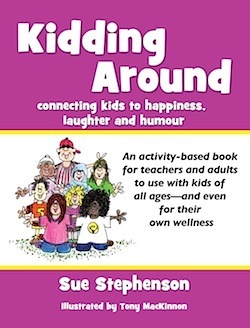How to Add Happiness and Humor to Your Classroom
Kidding Around: Connecting kids to happiness, laughter and humor
By Sue Stephenson
(Powerful Learning Press, 2014 – Learn more)

If laughter is the best medicine, where do you go to fill this prescription? The answer could be Sue Stephenson’s book Kidding Around: connecting kids to happiness, laughter and humor. Stephenson, who has been a teacher, principal and school leadership consultant, writes for a broad audience that includes parents, teachers, students and anyone interested in promoting the happiness and the emotional well-being of children.

Kidding Around is organized into three parts – happiness, laughter and sense of humor. At the end of each section she provides ideas for implementing the activities, ranging from “testing the water” to “jumping in the deep end,” so teachers can implement humor in a way that does not take them outside their comfort zone too quickly. In addition, each section has a useful list of books, apps, DVDs, games and websites for those who want additional information or inspiration.
Ways teachers might use Kidding Around
Teachers can use the book’s ideas in ways both big and small. I found myself marking several ideas that would be perfect for beginning-of-the year activities when I want to get to know my students. For example, I would like to try the activity called “Exploring our Funprints” in which students read different cartoons and rank them in order of funniness. This looks like a really enjoyable way to gain insight into my student’s personalities. At the same time they would gain an appreciation for the diversity we find in people’s sense of humor.
Other ideas could be used as daily routines – such as having students indicate where they find themselves in turns of happiness scale when they arrive in the morning. It could be very helpful to know who woke up on the wrong side of the bed before starting a new lesson.
Although the ideas are not linked to curriculum per se, teachers who want to integrate humor into a variety of content areas will have lots of food for thought. Possibilities for connecting humor to writing, speaking and listening standards are easy to see.
Teachers interested in “jumping into the deep end” should take a look at this MiddleWeb article by Sue Stephenson. She describes how a Toronto school she worked with successfully met standards with the help of a unit on comedy, which culminated in students performing their own stand-up routines for a real audience (there’s a video).
Many of the activities in Kidding Around allow teachers to meet academic standards while also addressing students’ social and emotional needs at the same time. In my book, that is a real win-win. Stephenson also includes classroom management tips for dealing with both class clowns and bullying.
What I liked best about the book is that many of the activities are aimed at helping kids to understand how they can promote their own happiness. There are activities that help them assess their state of mind and reflect on their own actions and feelings. Students should understand their role in their happiness and learn what they can do to contribute to their sense of well-being.
Many of the research-based ideas shared by Sue Stephenson are simple to implement and don’t require any special materials. So for any teacher who wants to add serious fun — even those teachers for whom fun does not come naturally — this book is the perfect solution.
Note: Kidding Around is a digital book, also available in a Spanish edition.
Jennifer Underwood, an elementary school teacher and former diplomat, taught fourth grade in an international school in Seoul, South Korea. She has since moved to Geneva, Switzerland, where she is working as a high school library assistant.
































